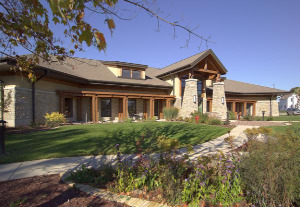
The Rosemary Garfoot Public Library is a central gathering place and a source of information for the Cross Plains community.
Partnered with Madison Gas and Electric, this library is Wisconsin’s first green library building. Its designers used the Leadership in Energy and Environmental Design (LEED) rating system to ensure the highest quality of sustainability. The seven key areas the LEED system evaluates are: sustainable sites; water efficiency; energy and atmosphere; material and resources; indoor environmental quality; innovation and regional priority. Forty to 49 points on the LEED system earns a building a “certified rating,” 50 to 59 points a “silver rating,” 60 to 79 points a “gold rating,” and lastly, 80 or more points a “platinum rating.” The library currently has a silver rating, but this may upgrade to gold soon.
One of many environmental features at the library is a rain garden, which soaks up rainwater from roofs, driveways, and lawns and gradually filters it into the ground instead of letting it run off to nearby storm drains. Compared to conventional lawns, rain gardens also reduce the chance of local flooding by allowing about 30 percent more water to soak into the ground.
And just inside the library, timber frames the lobby. The lobby’s circulation desk includes silver maple wood from trees on the library building’s site. The surface of the desk is compressed recycled paper, while the lobby’s entrance mat is recycled tires.
The building features other sustainable elements, too. Its columns and the display shelf on the foyer wall are made of recycled wood. The library’s carpeting is remnants of recycled carpets: this decorative technique makes it easy to replace carpet in a small area instead of having to replace a whole carpet. Behind the circulation desk is a set of windows that faces north and captures sunlight while minimizing the heat of the sun. The library’s ceiling fans reduce the need for air conditioning.
Further, motion and photo sensors control the lighting at the library. The building has an integrated “cool day lighting” design that is 40 percent more efficient than a traditional lighting design. Cork flooring lies under and around the circulation desk and in the reading, reference, and young adult areas located around the windows. The library’s paint and wall adhesives are non-toxic, water soluble, and do not add evaporated organic gases to the environment, thus avoiding what is commonly known as “new car smell.”
Moreover, the library’s story room includes a skylight ceiling design with baffles that filter the natural light that enters the room. The room also has a crafts area with laminate flooring, wheat board cabinets, a counter top covered with laminate, and a custom-built playhouse made of baltic birch plywood with a water-based polyurethane finish. Both restrooms in the library have high-efficiency flushing toilets that only use 1.1 to 1.6 gallons of water per flush and solar-powered, motion-sensitive sinks. The men’s restroom contains waterless urinals that use a filtration system instead of water. These features reduce water usage by thousands of gallons per year.
Near the library’s community rooms is the community kitchen, which has recycled vinyl flooring and wheat board cabinets covered with recycled laminate. The kitchen appliances have “Energy Star” ratings, which means they are the most energy-efficient products of their kind. The library also has a technical services room, offices, a staff room, and two study rooms. All the cabinetry and counter surfaces in these rooms are wheat board and recycled laminates. One of the study rooms features two hand-built cabinets that were generously created and donated by a talented library neighbor.
In addition, some green features of the building cannot be seen, like the insulation made of recycled jeans or the radiant floor heating along the windows that prevents fogging.
There are many buildings here in the Madison Area also designed using the LEED rating system. These include the DNR Co-Regional Headquarters, Lake Mills Elementary School, and the Badger Rock Center/Badger Rock Middle School.
[Sources:
Rosemary Garfoot Public Library
;
U.S. Green Building Council; Madison Gas and Electric
]

